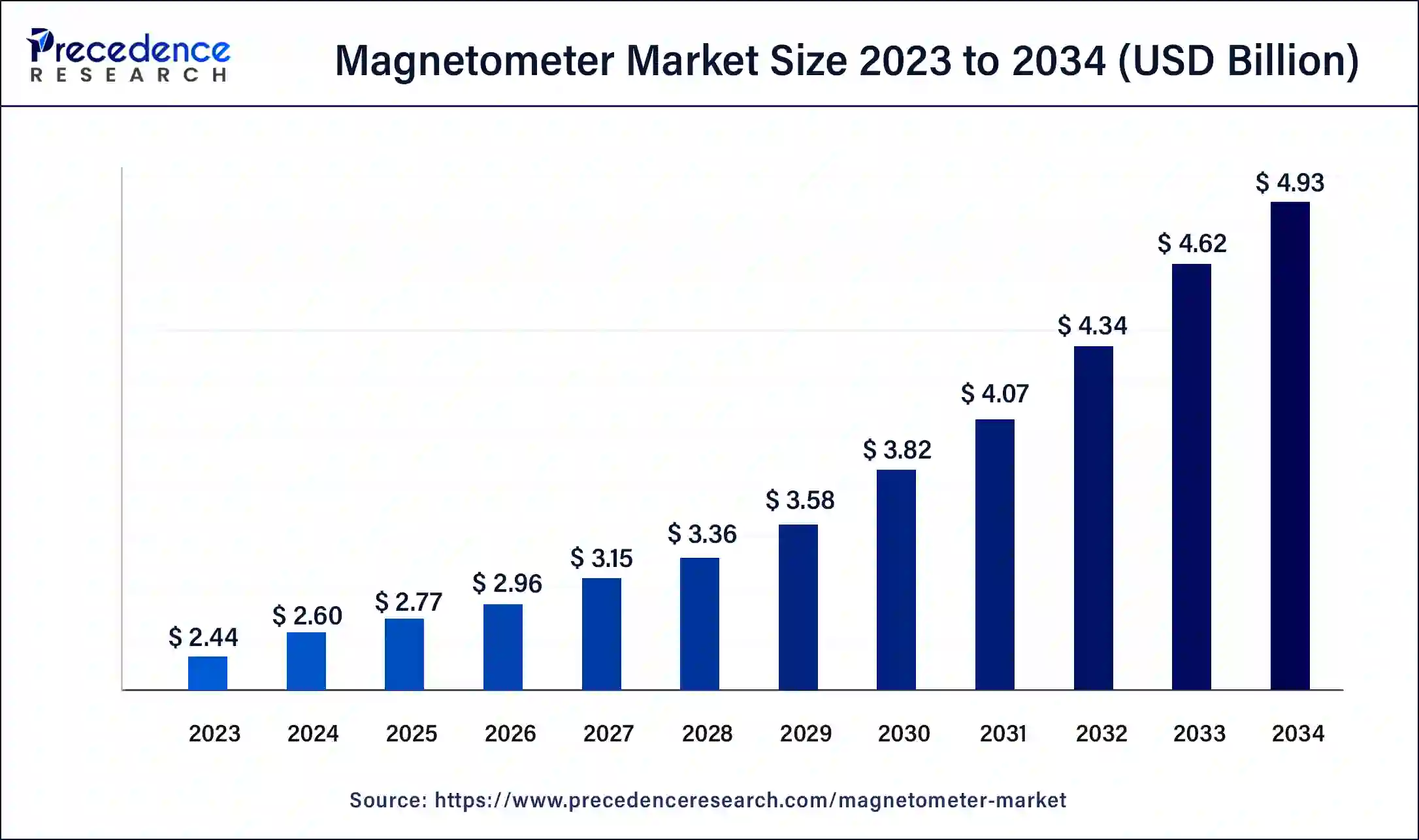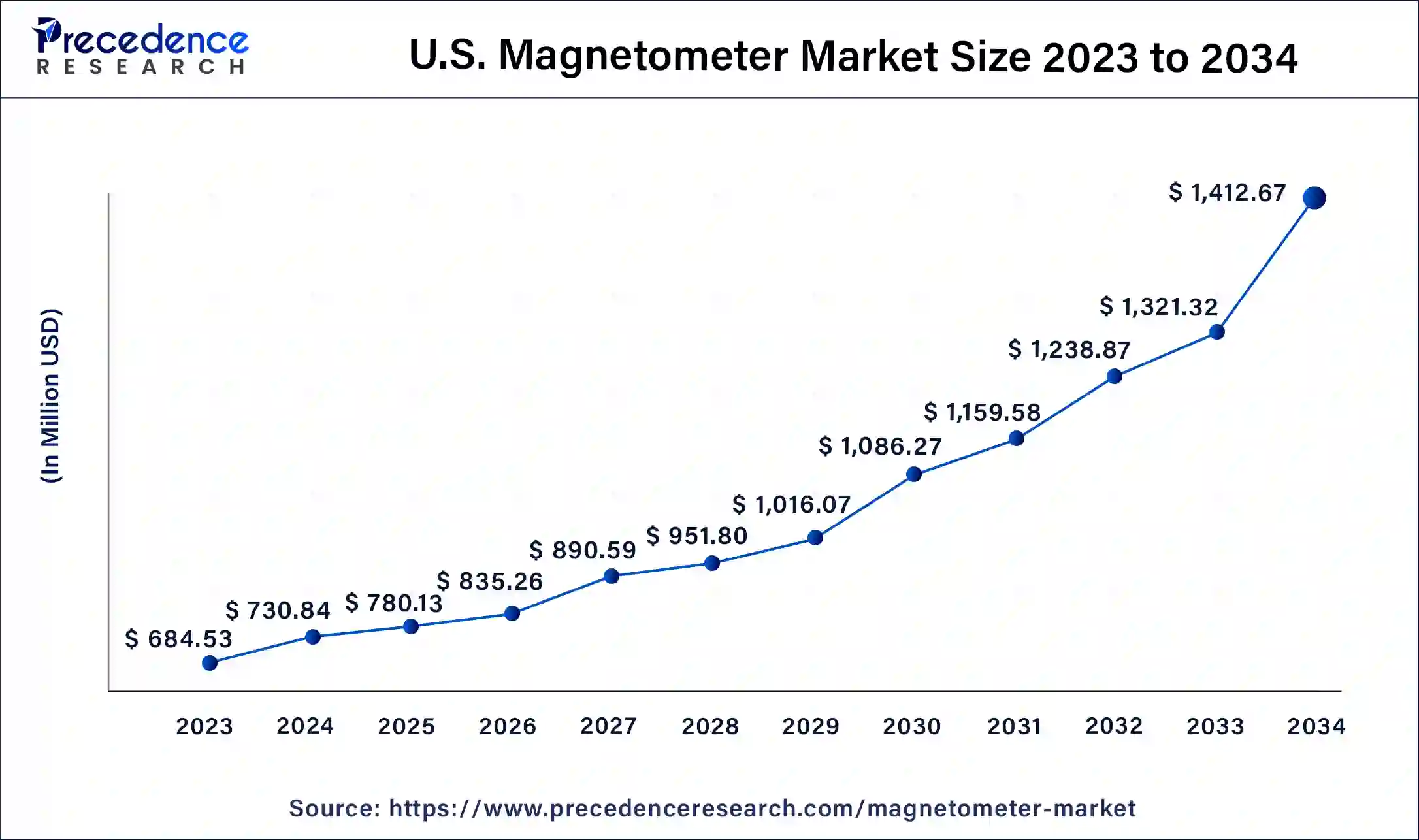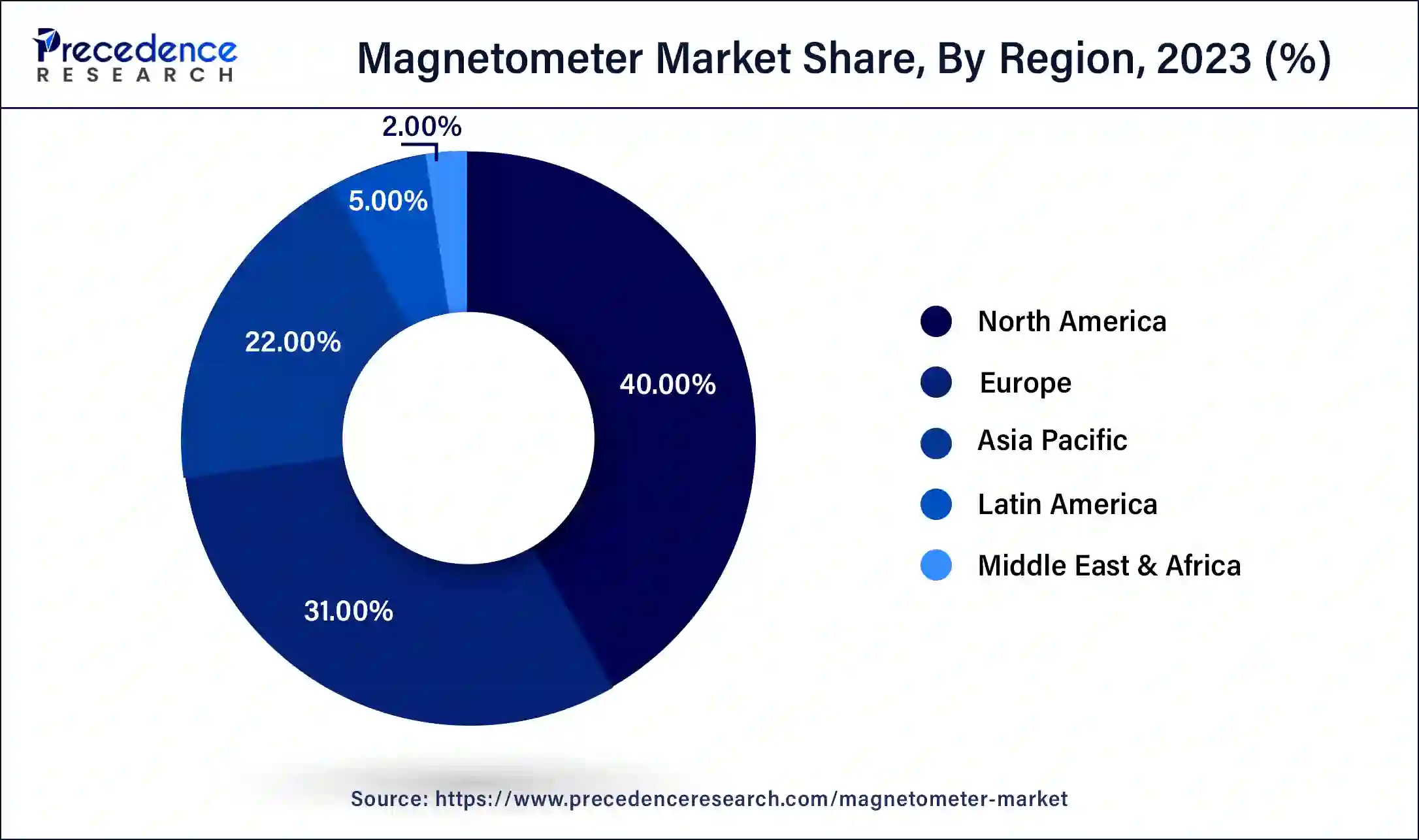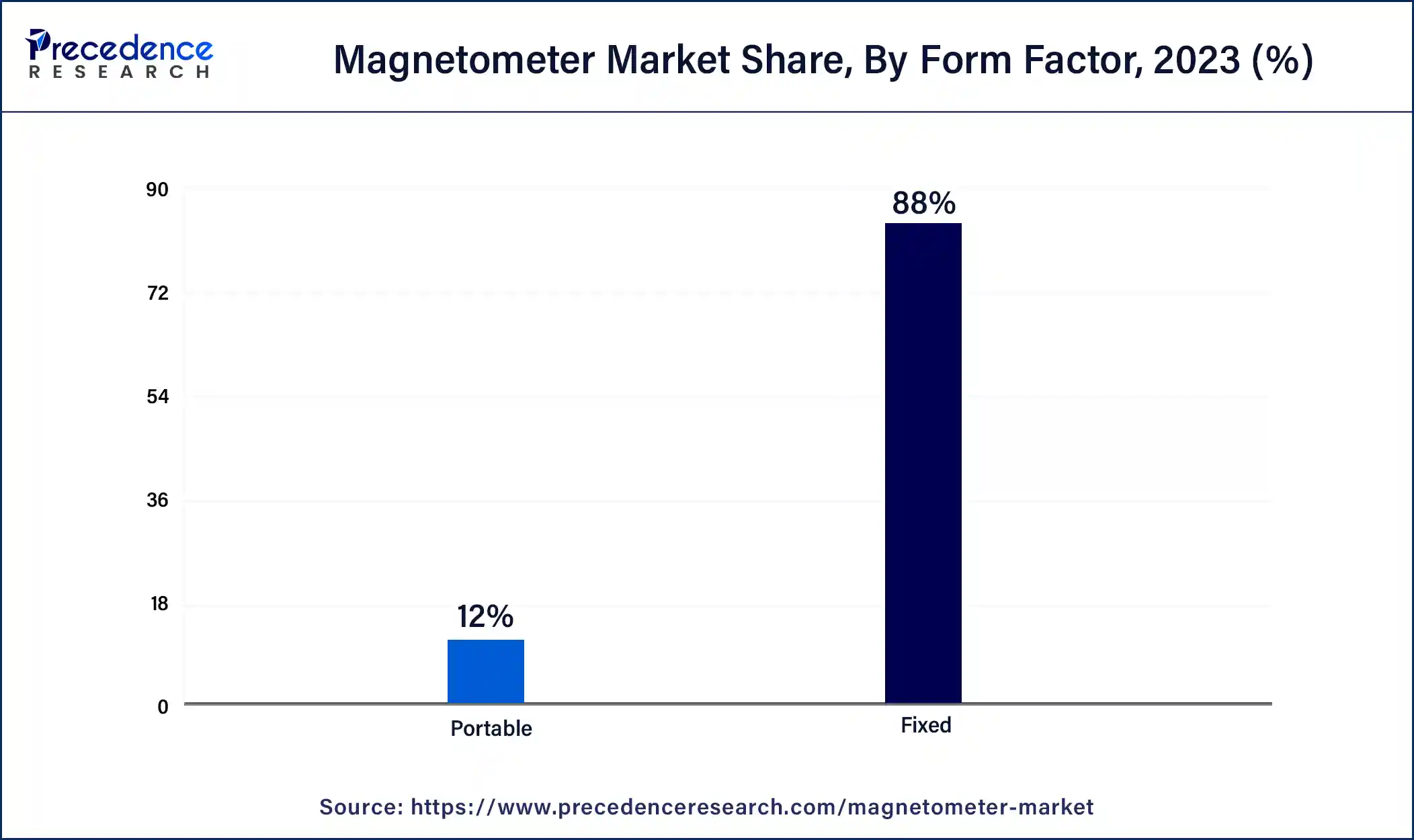The global magnetometer market size accounted for USD 2.60 billion in 2024, grew to USD 2.77 billion in 2025, and is projected to surpass around USD 4.93 billion by 2034, representing a healthy CAGR of 6.6% between 2024 and 2034. The North America magnetometer market size is calculated at USD 154.25 billion in 2024 and is expected to grow at the fastest CAGR of 4.85% during the forecast year.
The global magnetometer market size is expected to be valued at USD 2.60 billion in 2024 and is anticipated to reach around USD 4.93 billion by 2034, expanding at a CAGR of 6.6% over the forecast period 2024 to 2034.

The U.S. magnetometer market size is calculated at USD 730.84 million in 2024 and is projected to be worth around USD 1,412.67 million by 2034, poised to grow at a CAGR of 6.8% from 2024 to 2034.

North America has held the largest revenue share of 40% in 2023. North America, comprising the United States and Canada, dominates the magnetometer market due to robust technological infrastructure and demand from the automotive, aerospace, and defense sectors. The region's strong presence in space exploration and quantum technology drives magnetometer adoption. Additionally, growing applications in consumer electronics and the IoT sector further boost market growth. The trends in North America reflect a sustained focus on technological innovation and the diverse utility of magnetometers across industries, reinforcing the region's prominence in the market.

Asia Pacific is estimated to observe the fastest expansion. Asia Pacific commands a major growth in the magnetometer market due to several key factors. It stands as a global hub for manufacturing, particularly in the consumer electronics industry, where magnetometers are integral for navigation and spatial tracking. Moreover, the region's burgeoning automotive sector and the rising adoption of electric vehicles heavily depend on magnetometers for precision. Furthermore, the robust aerospace and space exploration endeavors in Asia Pacific contribute to the growing demand for these instruments. Combined with the region's technological advancements, it solidifies its pivotal role in the global magnetometer market.
A magnetometer is a highly advanced scientific tool meticulously crafted to accurately gauge the intensity and direction of magnetic fields in its immediate vicinity. It holds a pivotal role in a wide array of fields, spanning geophysics, archaeology, navigation, and space exploration. Magnetometers function by identifying changes in the properties of magnetic fields using purpose-built sensors engineered to be acutely responsive to magnetic forces.
In the realm of geophysics, magnetometers enable the detailed mapping and analysis of the Earth's magnetic field, aiding researchers in unraveling geological mysteries and uncovering insights about our planet's structure. In archaeology, they are instrumental in the detection and localization of hidden metallic artifacts, offering valuable glimpses into historical treasures. In navigation, magnetometers find their place in compasses and advanced electronic devices, ensuring precise direction determination.
Meanwhile, in the realm of space exploration, magnetometers serve as vital tools for probing the magnetic fields of celestial bodies, thereby enriching our understanding of their composition and history. In sum, magnetometers are indispensable instruments that facilitate a deeper comprehension of magnetic phenomena and find multifaceted applications in both scientific research and practical endeavors.
| Report Coverage | Details |
| Growth Rate from 2024 to 2034 | CAGR of 6.6% |
| Market Size in 2024 | USD 2.60 Billion |
| Market Size by 2034 | USD 4.93 Billion |
| Largest Market | North America |
| Base Year | 2023 |
| Forecast Period | 2024 to 2034 |
| Segments Covered | By Type, By Product Type, By Form Factor, and By Application |
| Regions Covered | North America, Europe, Asia-Pacific, Latin America, and Middle East & Africa |
Increasing demand in automotive industry and expanding aerospace applications
The magnetometer market has experienced a notable boost in demand due to the growing needs of the automotive industry and the expanding utilization of magnetometers in aerospace applications. In the automotive sector, magnetometers are indispensable for advanced driver assistance systems (ADAS) and the emerging field of autonomous vehicles. These systems heavily rely on the precision of magnetometers for accurate navigation and orientation, ensuring the safety and effectiveness of modern vehicles. With the increasing integration of ADAS features and the continuous expansion of autonomous vehicle technology, the requirement for dependable magnetometers is steadily increasing, driving market growth.
Simultaneously, the aerospace industry heavily relies on magnetometers for applications such as aircraft navigation, missile guidance, and space exploration. Magnetometers are crucial for maintaining proper heading, altitude control, and monitoring magnetic anomalies, which are essential for safe and accurate flight operations. With the increasing investment in space exploration missions and the development of aerospace technologies, the demand for high-performance magnetometers continues to grow, making the aerospace sector a significant driver of the magnetometer market. These two sectors collectively underscore the critical role of magnetometers in modern technology and are key drivers behind their increasing market demand.
Interference and calibration
Interference and calibration issues pose significant restraints on the magnetometer market's growth. Magnetometers are sensitive to external magnetic fields, and interference from nearby metallic objects, electrical equipment, or even natural geological features can disrupt their accuracy. This susceptibility to interference is a concern in various applications, particularly in environments with high magnetic noise. To counteract interference, magnetometers require frequent calibration and compensation, which can be time-consuming and may require specialized expertise. This complexity in maintaining the accuracy of magnetometer readings can deter potential users, as it increases the overall cost and effort associated with deploying these devices.
In sectors like aerospace, defense, and autonomous vehicles, where precision and reliability are paramount, the need for robust interference mitigation and calibration processes can slow down adoption. Addressing these challenges through technological advancements and innovative interference-reduction techniques is crucial to unlock the full potential of magnetometers in various industries and drive their market growth.
Space exploration and quantum technologies
Space exploration and the advent of quantum technologies are opening up substantial opportunities for the magnetometer market. In space exploration, magnetometers are indispensable for studying the magnetic fields of celestial bodies such as the moon, mars, and asteroids. These fields reveal crucial information about the composition and history of these celestial objects, positioning magnetometers as indispensable tools for future space missions. In the realm of quantum technologies, magnetometers are taking on a central role in high-precision measurements and sensing.
Quantum magnetometers, rooted in the principles of quantum mechanics, offer unparalleled sensitivity and accuracy. They are finding applications in quantum computing, quantum sensing, and emerging quantum technologies. These advanced magnetometers are set to revolutionize various industries, from geophysics to healthcare, by providing unmatched precision in magnetic field measurements. The intersection of space exploration and quantum technologies is driving innovation and expanding the frontiers of magnetometer applications, promising a prosperous path for the market.
In 2023, the vector magnetometer segment had the highest market share of 32% on the basis of the type. The vector magnetometer segment dominates the magnetometer market due to its crucial role in providing precise and comprehensive magnetic field measurements. Unlike scalar magnetometers, vector magnetometers offer data on the magnetic field's magnitude and direction in three dimensions, making them indispensable in applications demanding accurate orientation and navigation.
They find widespread use in geological surveys, aerospace, and advanced positioning technologies. With increasing reliance on autonomous vehicles, aerospace exploration, and precise spatial awareness, the demand for vector magnetometers continues to rise, solidifying their substantial market share as they cater to diverse sectors with high-precision magnetic field data.
The optical pumping segment is anticipated to expand at a significant CAGR of 6.9% during the projected period. The optical pumping segment commands significant growth in the magnetometer market due to its unparalleled precision and sensitivity. Optical pumping magnetometers utilize laser and optical techniques to measure magnetic fields with exceptional accuracy.
They are particularly favored in research, scientific, and high-tech applications where the highest levels of sensitivity and precision are required. These magnetometers offer advantages in terms of signal stability, making them indispensable for fields such as quantum research, medical imaging, and geological surveys. Their superior performance and versatility have established optical pumping magnetometers as a dominant growth in the magnetometer market.
According to the product type, the three-axis segment has held a 46% revenue share in 2023. The three-axis magnetometer segment dominates the market due to its ability to provide comprehensive and accurate measurements of magnetic fields in all spatial directions, making it highly versatile and sought-after. This segment is widely favored in various applications, including consumer electronics, automotive, aerospace, and geophysical surveys. Its 360-degree sensing capability offers superior performance for applications like navigation, device orientation, and environmental monitoring. As industries continue to demand precise and reliable magnetic field data, the three-axis magnetometer's ability to deliver comprehensive information in a compact form factor ensures its significant market share and sustained growth.
The single-axis segment is anticipated to expand fastest over the projected period. The single-axis segment commands a significant growth in the magnetometer market due to its versatility and cost-effectiveness. These magnetometers measure magnetic fields along a single axis, making them suitable for various applications, including consumer electronics and basic navigation systems. Their simplicity and affordability have made them the preferred choice in mass-market devices like smartphones and compasses. While other segments, such as three-axis and vector magnetometers, offer more comprehensive data, single-axis magnetometers continue to dominate the market, driven by their widespread adoption in everyday technology and applications where precision along a single axis suffices.
In 2023, the fixed segment had the highest market share of 88% on the basis of the form factor. Fixed segments dominate the magnetometer market primarily due to their reliability and consistent performance in various applications. Fixed magnetometers are stationary, often integrated into infrastructure or equipment, ensuring stability and accuracy over time. They are widely used in aerospace, defense, and industrial sectors where precise and continuous magnetic field measurements are critical. Their durability and low maintenance requirements make them an attractive choice.
Additionally, fixed magnetometers are well-suited for geophysical studies and long-term monitoring, driving their significant share in the market as industries increasingly rely on dependable and stable magnetic field data for critical operations.

The portable segment is anticipated to expand fastest over the projected period. The portable segment in the magnetometer market refers to compact and lightweight magnetometer devices designed for ease of mobility and field applications. This segment is witnessing a growing trend due to increased demand for on-site measurements, particularly in industries like archaeology, geophysics, and mineral exploration. Advancements in sensor miniaturization and power efficiency are driving the development of highly portable magnetometers. These devices provide professionals with greater flexibility and convenience for real-time, on-the-go magnetic field measurements, contributing to the growth of the portable magnetometer segment.
In 2023, the navigation segment had the highest market share of 28% on the basis of the application. In the magnetometer market, the navigation segment involves the use of magnetometers to determine accurate direction and positioning. Magnetometers are vital components in navigation systems, including GPS and inertial navigation, providing orientation and heading data.
A prominent trend in this segment is the integration of magnetometers into autonomous vehicles and drones, enabling precise navigation and obstacle avoidance. Additionally, magnetometers are becoming increasingly crucial for augmented reality (AR) and virtual reality (VR) applications, enhancing spatial tracking and immersive user experiences in various industries.
The medical devices segment is anticipated to expand fastest over the projected period. The medical devices segment in the magnetometer market encompasses the use of magnetometers in healthcare applications. This includes their integral role in magnetic resonance imaging (MRI) machines, which offer high-resolution diagnostic imaging.
A prominent trend in this segment is the ongoing development of higher-performance magnetometers to enhance the precision and sensitivity of MRI equipment, leading to more accurate and detailed medical imaging. Additionally, magnetometers are increasingly employed in emerging medical technologies for applications like non-invasive brain mapping and monitoring physiological parameters, reflecting a growing demand for these devices in the healthcare sector.
Segments Covered in the Report
By Type
By Product Type
By Form Factor
By Application
By Geography
For inquiries regarding discounts, bulk purchases, or customization requests, please contact us at sales@precedenceresearch.com
No cookie-cutter, only authentic analysis – take the 1st step to become a Precedence Research client